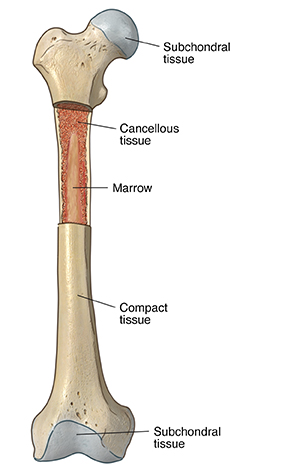Understanding Bones
What are bones?
Bone is living tissue that makes up the body's skeleton. There are 3 types of bone tissue:
-
Compact tissue. This is the harder, outer tissue of bones.
-
Cancellous tissue. This is the sponge-like tissue inside bones.
-
Subchondral tissue. This is the smooth tissue at the ends of bones, which is covered with another type of tissue called cartilage. Cartilage is a specialized, rubbery connective tissue.

The tough, thin outer membrane covering the bones is called the periosteum. Under the hard outer shell of the periosteum are tunnels and canals. Through these, blood and lymphatic vessels carry nourishment for the bone. Muscles, ligaments, and tendons may attach to the periosteum.
Types of bones
Bones are classified by their shape. They may be long (like the femur and forearm), short (like the wrist and ankle), flat (like the skull), or irregular (like the spine). Primarily, they are referred to as long or short.
There are 206 bones in the adult human skeleton. This doesn’t include teeth or small bones found within tendons called sesamoid bones. The 206 bones include:
-
80 axial bones. This includes the skull, hyoid, auditory ossicles, vertebral column, ribs, and sternum.
-
126 appendicular bones. This includes arms, shoulders, wrists, hands, legs, hips, ankles, and feet.
What are the functions of bones?
Bones give shape and support for the body. They give protection to some organs. Bone also serves as a storage site for minerals. And soft bone marrow in the center of certain bones is where blood cells are formed and stored.
What are the different types of bone cells?
The different types of bone cells include:
-
Osteoblast. This type of cell is found along the surface of the bone. Its function is to form new bone tissue, remodel bones while aging, and heal damaged bones.
-
Osteoclast. This cell is larger than osteoblasts and are found within the bone itself. Its function is to dissolve, reabsorb, and remove unwanted bone tissue.
-
Osteocyte. This type of cell is within the bone. It helps to maintain bone as living tissue.
-
Hematopoietic. This type of cell is found in bone marrow. Its function is to make red blood cells, white blood cells, and platelets.
Fat cells are also found in the bone marrow.
Online Medical Reviewer:
Heather M Trevino BSN RNC
Online Medical Reviewer:
Susan K. Dempsey-Walls RN
Date Last Reviewed:
2/1/2024
© 2000-2024 The StayWell Company, LLC. All rights reserved. This information is not intended as a substitute for professional medical care. Always follow your healthcare professional's instructions.